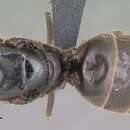en
names in breadcrumbs


This genus is represented in California by two species, both widespread. These ants have populous colonies that inhabit the trunks of large living trees, especially those of oak and pine. L. occidentale Emery tends to be associated with deciduous trees, while L. luctuosum Wheeler is found most frequently in conifers. The workers forage in large files and are generalist scavengers and predators, as well as active tenders of aphids and scale insects.
Species identification: key in Wheeler and Wheeler (1986g). Additional references: Disney (1982), Gulmahamad (1995), Kistner et al. (2002), Shapley (1920), Snelling and George (1979), Wheeler (1905h).
In meinen Europ. Form. ist bei dem Gattungscharakter des [[ queen ]] auszulassen: „ Die Stirnrinne tief. Thorax niedrig, flachgedrueckt. Stielchen mit scharf bogenfoermig ausgeschnittener Schuppe. "
Liometopum is a genus of ants that belongs to the subfamily Dolichoderinae,[2] found in North America, Europe and Asia.[3]
Caterpillars of certain butterfly species have a symbiotic relationship with Liometopum ants. They produce secretions that the ants will feed on, similar to the behavior of the ant genus Iridomyrmex.
Liometopum is a genus of ants that belongs to the subfamily Dolichoderinae, found in North America, Europe and Asia.
Caterpillars of certain butterfly species have a symbiotic relationship with Liometopum ants. They produce secretions that the ants will feed on, similar to the behavior of the ant genus Iridomyrmex.